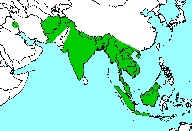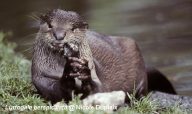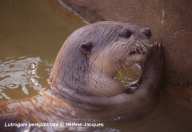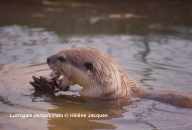
Click map for larger version |
|
|
|
Description
This large, stoutly build otter has short, velvety fur, hence its name. On the head and back, the fur is darkest, blackish brown in L. p. perspicillata, but sandy in L. p. sindica. The throat is pale, shading to a paler shade of the dorsal colour on the belly. The third subspecies, L. p. maxwelli from Iraq, is altogether darker, with an iron grey throat and the underside very little paler than the top. No spotting or streaking is shown in this species. The final half of the tail is markedly flattened, and the feet are relatively large, webbed to the last knuckle, with short, sharp, strong claws. The skull is rounded, with massive teeth and a short muzzle. This otter is around 1.2m long and weighs about 11kg. It is maily a fish eater, taking larger prey than the four species that share parts of its range - the Eurasian, Hairy-Nosed and Asian Small-Clawed Otters. It also eats shrimp/crayfish, crabs, insects, frogs, mudskippers, birds and rats. Typically, these otters live in family groups of a male, a female and the current set of cubs. In former times, this species was widely employed throughout its range by fishermen, with trained animals being highly valued.
CITES Identification Sheet
Habitat
Smooth-Coated Otters like large rivers, lakes, peat swamp forests, coastal mangroves, estuaries and rice fields, provided there is ample bankside vegetation for cover and escape, and rocky areas or deep soil for digging natal holts. They are widespread in lowland habitats, but have been recorded historically from 1830m (Yunnan). They have been seen swimming out to sea, and in Sumatra are even called Sea Otters: they need adequate fresh water to wash the salt from their fur.
Distribution
This species is found in Java, Sumatra and Borneo, northward to south-western China, east through Nepal and Bhutan and India to Pakistan, excluding the Indus Valley (due to barrages and dams). Thereis an isolated population in the marshes of Iraq (L. p. maxwelli), indicating the range must once have been wider.
Conservation Status
Red List Category VU (Vulnerable), population trend decreasing
Year Assessed 2014
Assessor Khan, W
Evaluators Hussain, S.A. (Otter Red List Authority)
The area occupied by these animals has reduced significantly in the last 10 years as development of their habitat takes place. Some authorities consider that decline may be occuring faster than generally thought, and ex situ conservation has been recommended.
(Source: IUCN Red List)
Current Concerns
Increasing human population across its range is putting this species under pressure through habitat destruction (large hydroelectric projects, wetland reclamation), pollution (pesticide and agricultural run-off leading to eutrophication of waterways and reduction in prey biomass), and serious, widespread conflict with aquaculturalists and fishermen who kill them as pests and competitors, and deliberate trapping for fur in India, Nepal and Bangladesh, mainly for export to China. Although technically legally protected throughout its range, this is laxly enforced; some local authorities actively encourage otter killing by fishery interests. Movement over much of its apparent range is limited due to arid regions, leading to poor dispersal and population fragmentation. Although in the past, this otter has been plentiful and the population apparently stable, it is now likely that this is changing rapidly and these otters will soon be in need of urgent help. Several authorities have recommended that ex situ as well as in situ conservation efforts should be made.
Researchers
Source: Padma K de Silva,
IUCN/SSC Asian coordinator
| S.A. Hussain |
|
India |
|
Ecological studies on smooth coated otter in Periyar lake, South India. |
| M.Feeroz |
|
Bangladesh |
|
Status, distribution and use of otters in fishing of otters in Sundarbans, Bangladesh |
| |
|
|
|
Captive breeding and reintroduction of confiscated otters in Bangladesh. |
| Paras Acharya |
|
Nepal |
|
Distribution of smooth coated otter in Rapti river, Chitwan National Park |
| Omar Al-Sheikly |
|
Iraq |
|
Distribution and ecology of smooth-coated otter in Iraq |
Publications
General
- Harris, C.J. (1968). Otters: A Study of the Recent Lutrinae. Weidenfeld and Nicholson, London
- Bree, P.J.H. van (1968). Über ein Exemplar von Lutrogale perspicillata (Geoffroy, 1826), (Mammalia, Carnivora) aus Bhutan. Zoologische Anzeiger, 180 (1/2): 162-164
- Bree, P.J.H. van (1968). Einige Bemerkungen über den Glattotter, Lutrogale perspicillata (Is. Geoffroy,1926)(Carnivora, Lutrinae), aus dem Indo-Australischen Archipel. Der Zoologische Garten, 35 (1/2): 30-36
- Hayman, R.W. (1957). A New Race of the Indian Smooth-Coated Otter from Iraq. Ann. Mag. Nat. Hist., 9 (12): 156-159
Ecology
- Al-Sheikhly, O.F. and Nader, I.A. (2013). The Status of Iraq Smooth-Coated Otter Lutrogale perspicillata maxwelli Hayman 1956 and Eurasian Otter Lutra lutra Linnaeus 1758 in Iraq IUCN Otter Spec. Group Bull. 30 (1): 18 - 30
- Haque, M.D.N. & Vijayan, V.S. (1995). Food Habits of the Smooth Indian Otter (Lutra perspicillata) in Keoladeo National Park, Bharatpur, Rajasthan (India). Mammalia, 59: 345-348
- Hussain, S.A. (1996). Group Size, Group Structure and Breeding in Smooth-Coated Otter Lutra perspicillata (Geoffroy) (Carnivora, Mustelidae) in National Chambal Sanctuary, India. Mammalia, 60: 289-297
- Kruuk, H., Kanchanasaka, B. et al (1994). Niche Separation in Three Sympatric Otters Lutra perspicillata, L. lutra and Aonyx cinerea in Huai Kha Khaeng, Thailand. Biological Conservation, 69: 115-120
Fishing
- Biswas, R.N. (1973). On the Domestication of the Otter by Fishermen in Bangladesh J. Bombay Nat. Hist., 70 (2): 374-375
- Gudger, E.W. (1927). Fishing with the Otter. American Naturalist, 61: 193-225
Threats
Useful Links
|





